Garfield Flat Stock Tank Pond
Garfield 5890 Saddle Pond
Winter 2022 Fairy Shrimp Hatching History in the Garfield and Candelaria Hills and the Gabbs Valley Range
What Can We Learn from the Ponds in the Garfield Hills?
The Garfield Hills are not a linear range but 2 groups of hills separated by a valley. They are bounded on the north and east by Soda Spring Valley. To the west, Whiskey Flat separates them from the Wassuk Range. The Excelsior Mountains are to the south. The valley between the hills terminates to the southeast at Garfield Flat. The Garfield Hills are about 35 km (22 miles) across from Whiskey Flat east to Mina and about 24 km (15 miles) across from US 95 east of Hawthorne south to the dry creek bed through Rattlesnake Flat.
The Garfield Hills are generally above 1,750 m (5,740′) but dip to 1,500 m (4,920′) adjacent to Soda Spring Valley. The highest elevation is Mable Mountain, at 2,443 m (8,020′).
Desert scrub at the lower elevations gives way to sagebrush on the highest hills. There are rare pinyon and juniper.
Except for Garfield Flat, the Garfield Hills are public land managed by the Stillwater Office of the BLM. Garfield Flat is within a 16-section (nominally 10,240 acres, 4,150 hectares) block of private land. The playa within this block is surrounded by a chain-link fence with warning signs because it was previously used as a bombing range. There are a few square towers made of four metal posts and five metal decks around the periphery of the playa and within the fence. The more extensive private land outside the fence is apparently open to the public as there are no other fences or No Trespassing signs. There are also patented mining claims scattered across the northeastern group of hills near the Good Hope, La Planta, Garfield, Blue Ribbon, and Bataan mines and southeast of the Bataan Mine.
US 95 swings around the north and east sides of the Garfield Hills. There is a well-maintained road through the hills from Mina west to Garfield Flat and then north to US 95 about 9 miles east of Hawthorne.
Garfield Flat Stock Tank Pond (private)
___This map is a screenshot of The National Map (Go to The National Map). The U.S. Geological Survey generally does not copyright or charge for its data or reports (unless printed). A pond location is indicated by an “X”, which corresponds to the coordinates given in the data spreadsheet. Labels in quotations are from 7.5-minute topographic quadrangles.
___Red lines are the U. S. National Grid with a spacing of 1,000 m and intersection labels consisting of the UTM zone (e.g., 11S, 12T), a 2-letter 100-km square designation (e.g., LC, XN), and a 4-digit number. The first 2 digits of the number represent the 1,000-meter Easting and the second 2 digits the 1,000-meter Northing, as seen in the example Easting and Northing. Unlike latitude and longitude, the National Grid is rectilinear on a flat map, the units of abscissa and ordinate have equal lengths, and the units (meters) are measurable on the ground with a tape or by pacing.
___Gray shading represents private land as traced from the PAD-US 2.0 – Federal Fee Managers layer of The National Map. Other lands are public.
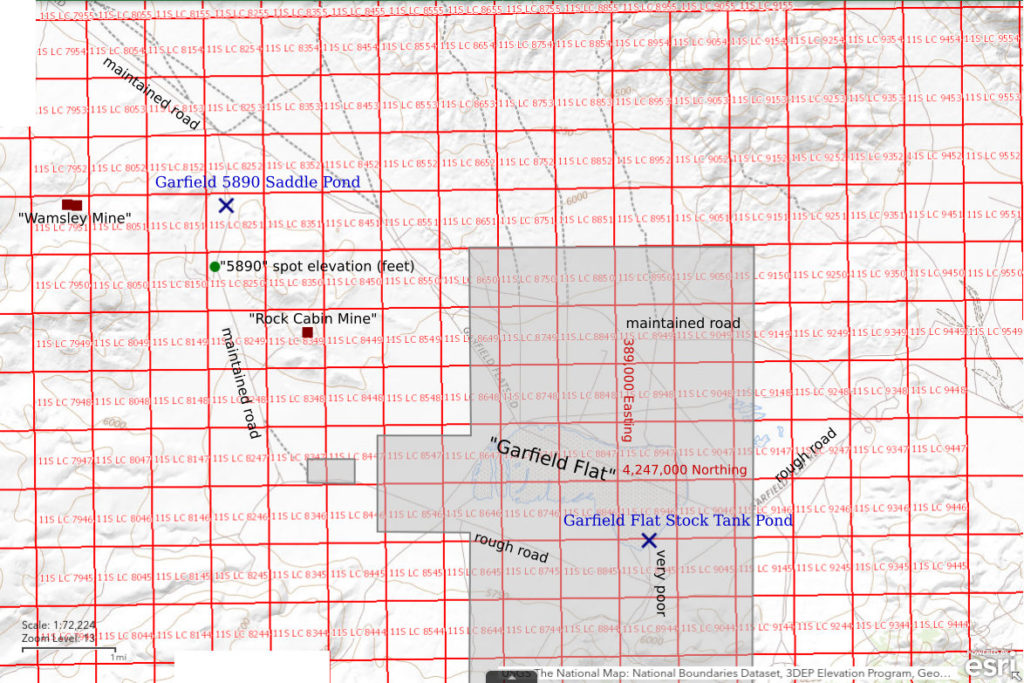
Garfield Flat Stock Tank Pond is at the southeast edge of Garfield Flat 14 km (9 miles) southwest of Mina. Garfield Flat is in a round basin between the Garfield Hills to the north and the Excelsior Mountains to the south. The stipple pattern for the Garfield Flat playa on the 1:100,000-scale BLM map is 3.7 km (2.3 miles) long and 1.3 km (0.8 miles) wide. The well-maintained Garfield Flat road passes north of the playa and several rarely to moderately used unimproved roads also cross the private land. At the southeast corner of the playa, one metal tower is located close to a small steel stock tank, which is outside the fence. A large diked area next to the tank collects water and is the Garfield Flat Stock Tank Pond.
The Garfield Flat Stock Tank Pond is accessible from the well-maintained Garfield Flat road, which meets US 95 9 miles east of Hawthorne and again at Mina. The southern edge of the playa and the pond is best accessed from the east. There is a bumpy, rocky, sandy road that leads from the Garfield Flat road to an intersection north of Garfield Spring and south of the east end of Garfield Flat. From there, a long disused 2-track leads about 800 m (2,620′) toward the tower by the stock tank and pond. It is an easy walk.
Elevation: 1,693 m (5,555′)
March 15, 2019
Water covers about one-third of the surface of Garfield Flat playa. Water within the dikes of the stock pond is continuous with water on the playa.
- Maximum dimensions of water on playa more than 1,000 m but dikes for stock pond enclose an area less than 30 m x 30 m; water on playa less than 2 cm deep where accessible outside the fence, depth in stock pond uncertain.
- Opaque pale grayish-brown water.
- Sparse (0 to 2 per net) pale gray fairy shrimp of two size classes: 15-20 mm with yellow eggs in large ovisacs and about 10 cm; no fairy shrimp found on the playa outside the fence.
- Other animals not noted.
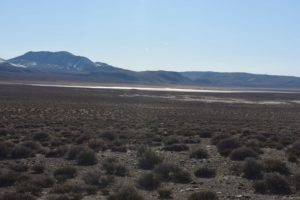
View west at Garfield Flat playa catches the sunlight reflecting off the water. There may also be some ponds in the paler area of sand dunes below the playa. The Garfield Flat Stock Tank Pond is at the left edge of the reflection. The hills at left are the Excelsior Mountains.
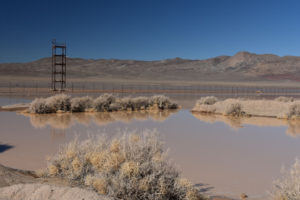
Garfield Flat Stock Tank Pond, looking north with Garfield Hills in the distance. The water is continuous from the playa through the low spots in the dikes around the pond. The steel tower is on the former bombing range, which is surrounded by a chain-link fence.
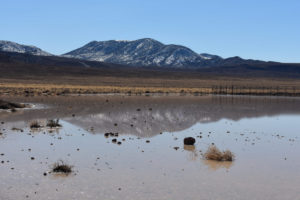
Looking southwest across the feather-edge of water on Garfield Flat playa in the vicinity of Garfield Flat Stock Tank Pond. The many small rocks protruding above the water indicate how shallow it is. No fairy shrimp were found in this very shallow playa water.
May 13, 2019
The greasewood has green leaves and the water is gone.
- Dry.
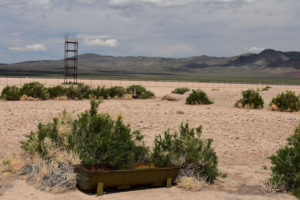
Garfield Flat Stock Tank Pond, looking north toward the Garfield Hills in a view similar to photograph Garfield Flat Stock Tank Pond 2019-03-15, #02. The metal stock tank is in the foreground.
February 17, 2022
It’s been almost 2 months since the big December snow and 1/3 to 1/2 of Garfield Flat playa is covered by water. There is more water around the pond than on March 15, 2019 and it is, again, continuous with water on the playa. About 1/3 of the pond is covered by ice. It is a calm day and water on the playa, which is less than 3 cm deep south of the fence, is clear. Within the dikes of the pond, the upper 1-2 cm of water is clear but it is opaque clay soup below a sharp boundary.
- 25 m x 30 m within dikes; depth at least 30 cm, maybe up to 35 cm.
- Opaque whitish-brown water; 6 C in 5 cm water away from the ice at 1415.
- No fairy shrimp.
- Raven.
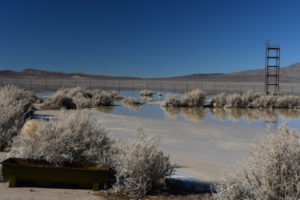
View to northwest across Garfield Flat Stock Tank Pond with the tank at lower left. Ice is on the water in the foreground and at left. The water continues out onto the playa beyond the fence.
February 28, 2022
Driving to the pond, I got worried that everything had dried up because Garfield Flat playa was mostly white. Turned out, though, that all that white was ice and not dry clay. Closer to the pond, the playa was covered by less than 2 cm water. Then the real surprise: the pond itself was still completely covered by ice up to 3 cm thick at 1030. Much of the ice was rotten, cellular stuff. No point sticking around to watch ice melt, so I drove off to check on Candelaria Playa Ponds. When I came back at 1500, almost all of the pond was still covered by ice even though the water was relatively warm.
- 25 m x 30 m within dikes; depth not estimated.
- Opaque whitish-brown water; 5 C at 1030, 9 C at 1500.
- Too much ice to see if fairy shrimp are present.
- Couldn’t see anything else through the ice either.
March 14, 2022
Another try to see if the fairy shrimp have hatched. The pond still covers the area within the dikes and there is no ice. Some water extends out onto the nearby playa. The rest of the playa is damp and brown or dry and nearly white.
- 25 m x 30 m within dikes; depth 20 cm.
- Opaque whitish-brown water; 10 C at 1530.
- Rare (1 per 5 nets) fairy shrimp either about 5 mm or about 10 mm long; I caught them only near the shore, not in the deeper water, which is presumably cooler.
- No other animals observed.
Yes, they finally did hatch. A colder microclimate may explain why they hatched later than those in Garfield 5890 Saddle Pond. If the ice wasn’t enough to prove Garfield Stock Tank Pond is colder in spite of its lower elevation, measured temperatures on 3 dates were always lower in Garfield Stock Tank Pond compared to Garfield 5890 Saddle Pond.
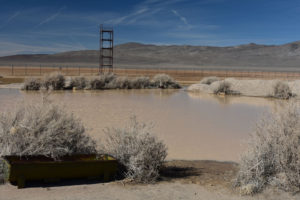
Garfield Flat Stock Tank Pond, view similar to photograph Garfield Flat Stock Tank Pond 2022-02-17, #01. No ice this time. The playa in the distance is damp and brown.
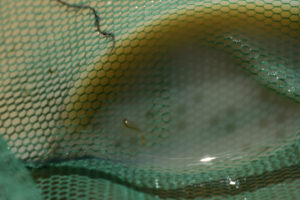
Single fairy shrimp in net at Garfield Stock Tank Pond. This one is of the smaller (younger) generation.
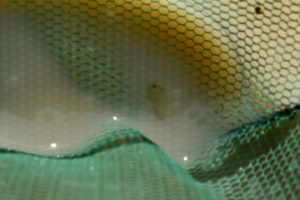
Single fairy shrimp in net at Garfield Stock Tank Pond. This one is of the larger (older) generation. It is a male with its large antennae II to the right of the head.
April 1, 2022
The budsage has leafed out and is blooming. The water level has pulled back from the bushes ringing the pond and doesn’t extend out onto the playa. There is floating green algae in a band less than 30 cm wide along the shoreline. There are small flies on the algae and the wet mud at the edge of the water.
- 20 m x 28 m; depth 15 cm.
- Opaque whitish-brown water; 20 C at 1500.
- Fairy shrimp of various sizes with larger ones about 15 mm long and smallest about 8 mm; some are pale gray and some are greenish-brown; as before, I caught them only near the shore, even among the slimy algae.
- Flies (alkali flies?).
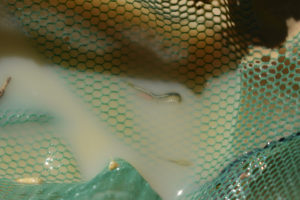
2 fairy shrimp of different sizes in the net at Garfield Flat Stock Tank Pond. The female at top is about 15 mm long and has an ovisac filled with pinkish eggs. The smaller fairy shrimp at bottom is barely 8 mm long. The large difference in size indicates these 2 fairy shrimp hatched on different days.
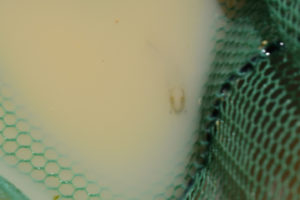
A male fairy shrimp with clearly visible antennae II in the net at Garfield Flat Stock Tank Pond. The distal segments of the antennae II are curved, appear to be tubular, are almost as long as the basal segments, and nearly touch over the center-line of the body. This is similar to those of fairy shrimp in
- Jungo Flat Playa Lake in Desert Valley,
- Macari East Stop Sign Pond and Bass Flat Southwest Pond on “Carson Lake” Playa,
- Luning Playa Narrow Pond in Soda Spring Valley,
- North Smith Creek Playa Channel Ponds in Smith Creek Valley, and in
- Bald Mountain Big Dry Lake in the Pine Grove Hills.
Garfield 5890 Saddle Pond (Stillwater BLM Office)
Garfield Flat Stock Tank Pond map
Garfield 5890 Saddle Pond is northwest of Garfield Flat and 21 km (13 miles) west of Mina. The pond is on the saddle of a ridge between the Wamsley and Rock Cabin mines (names on 1:100,000-scale BLM map). The Mable Mountain 7.5-minute topographic quadrangle shows the pond and has a spot elevation of 5,890 feet (1,795 m) on the saddle about 1 km (0.6 miles) to the south. The pond is within an excavation about 2 m (6 1/2′) deep. It is surrounded by a barbed wire fence that is mostly down.
The Garfield 5890 Saddle Pond is accessible from the well-maintained Garfield Flat road, which meets US 95 9 miles east of Hawthorne and again at Mina. A road that is occasionally graded forms a Y to the south off the Garfield Flat road about 12 miles from US 95 east of Hawthorne and about 26 miles from Mina. This road goes over the saddle and continues down to the west end of Garfield Flat. The fence around the pond is visible from the road. The pond is less than 100 m (330′) from the road.
Elevation: 1,805 m (5,920′)
February 17, 2022
This saddle seems like an odd place for a stock pond but here it is. There are even a few cows here. The banks of the excavation are deeply eroded so the pond may get some runoff during heavy rains. The water in it now, though, must have come from snow. In spite of the present cows, the pond has not been heavily trampled. I could walk through the water rather easily.
- 15 m x 22 m for water, excavation is bigger; depth at least 10 cm, maybe up to 15 cm.
- Opaque pale brown water; 9 C in 2 cm water at 1530.
- Sparse (e.g., 1 per 5 nets), pale gray fairy shrimp 5-8 mm long; didn’t see eggs.
- Didn’t see other animals.
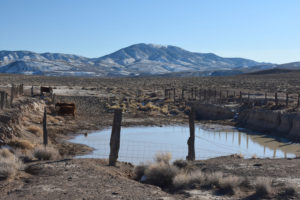
View to south across Garfield 5890 Saddle Pond, with Excelsior Mountains in distance. Although there are cows here now, the pond hasn’t been heavily trampled.
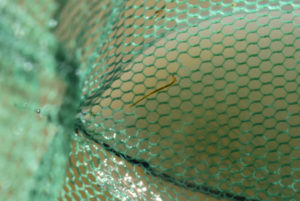
Fairy shrimp in Garfield 5890 Saddle Pond. Without the greenish brown food in the intestine and the black eyes, these fairy shrimp would be almost invisible. The small size indicates a relatively recent hatch.
It was a surprise to find fairy shrimp had hatched here but not in Garfield Flat Stock Tank Pond, which is about 100 m (330′) lower. However, Garfield Flat Stock Tank Pond evidently has a colder microclimate. It had ice less than 2 hours ago and was 3 C cooler. Maybe there is a thermal inversion or maybe the excavation that Garfield 5890 Saddle Pond is in traps heat better than the more open and windier Garfield Flat.
February 28, 2022
I decided to make another trip to see if I could find fairy shrimp at Garfield Stock Tank Pond and this was on the way. The weather had warmed up but the pond was still covered by 8 mm ice at 0930, contrary to my hopes. Lesson of the day: it takes hours for ice to melt even at mild air temperatures. Came back after visiting Garfield Stock Tank Pond and Candelaria Playa Ponds and the ice was all gone.
- 13 m x 20 m; depth at least 7 cm, maybe up to 10 cm.
- Opaque pale brown water; 6 C at 0930, 15 C at 1615.
- Fairy shrimp of various sizes up to 10 mm long; didn’t see eggs.
- No other animals.
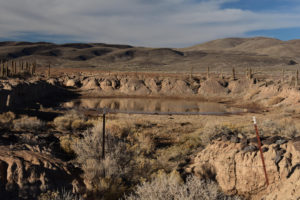
Garfield 5890 Saddle Pond, looking north with Garfield Hills in the distance. No ice now. The heavily eroded banks indicate overland flow into the pond at times.
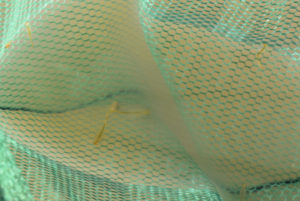
A few fairy shrimp in the net at Garfield 5890 Saddle Pond. The 2 below and to left of center look bigger than the 2 at upper left and upper right. The fairy shrimp are a little blurry due to the 1/25 second shutter speed but it’s clear that none have ovisacs yet, much less eggs.
March 14, 2022
The pond is significantly reduced in size. Numerous cow pies indicate cows have been drinking the water.
- 13 m x 16 m; depth at least 4 cm.
- Cloudy pale brown water; 20 C at 1400.
- Fairy shrimp mostly about 12 mm long but a few smaller and maybe about 8 mm; most are the usual very pale gray but a few are distinctly bluish-green; larger fairy shrimp of both colors have eggs; where they can be seen near the water’s edge, almost all the fairy shrimp are legs down scraping the bottom mud.
- No other animals.
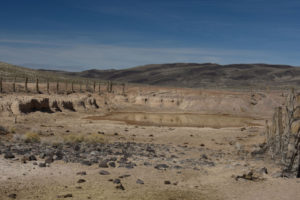
Garfield 5890 Saddle Pond, looking north with Garfield Hills in distance. The width is about the same as February 28 but the length and depth are significantly less. I am standing to the right of where I was for photograph Garfield 5890 Saddle Pond 2022-02-28, #09.
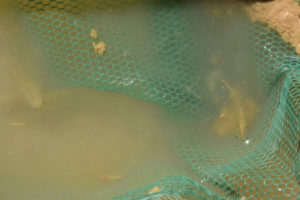
Fairy shrimp in net at Garfield 5890 Saddle Pond. The male at right has clearly visible antennae II with basal and distal segments of about the same length and curved distal segments that just touch each other above the legs.
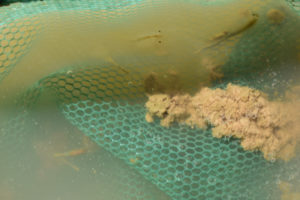
Fairy shrimp (and mud) in net at Garfield 5890 Saddle Pond. The female at upper right has a full ovisac. There is another full ovisac at lower left but the rest of that female is obscured by a fold in the net.
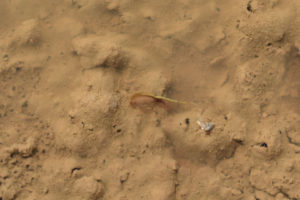
Fairy shrimp at the edge of the water in Garfield 5890 Saddle Pond. Like most of the fairy shrimp, this one is inverted (back facing up) and is scraping the pond bottom with its legs. That the material in the intestine past the middle of the thorax is very pale suggests it may include some clay.
Garfield 5890 Pond Fairy Shrimp Video 2022-03-14cm-r
For a 2-minutes, 2-seconds video of fairy shrimp swimming near the edge of Garfield 5890 Saddle Pond, click on the video player above. There is no audio. The video opens with photograph Garfield 5890 Saddle Pond 2022-03-14, #08, for context. The water at the edge of the pond is shallow enough that it is possible to see the fairy shrimp swimming back and forth foraging for food. There is a light breeze pushing the water from left to right. Brown eggs can be seen in the ovisacs of some fairy shrimp. The female on the left side at 1:08-1:20 looks like it has 2 short rows of white eggs in its oviducts. The female at the lower right edge at 1:25-1:30 appears to have a darker bluish color than the others. This video demonstrates than even in a pond with opaque water, fairy shrimp can sometimes be seen without the aid of a net.
April 1, 2022
The recent warm temperatures have left only damp mud in Garfield 5890 Saddle Pond.
- Dry.
There are abundant fairy shrimp remains concentrated in an area of about 4 m x 7 m in the northeastern quadrant of the pond. Most of the remains are about 15 mm long but there may be some up to 20 mm and there is a smaller population about 10 mm long. Eggs are common.
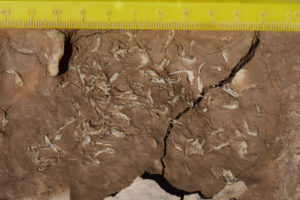
Remains of fairy shrimp on the bottom of Garfield 5890 Saddle Pond, with scale in centimeters. Considering the curvature and the fact that the tip of the abdomen may be missing, most seem to be about 15 mm long. These could be members of the 12 mm generation of March 14. Some are distinctly smaller and probably represent a younger generation. The small isolated remains below and to the right of center measure about 6 mm, or 7 mm allowing for a missing abdomen tip.
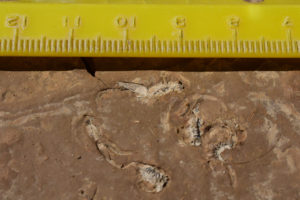
Close-up view of desiccated fairy shrimp remains in Garfield 5890 Saddle Pond. The female next to the scale died with an ovisac full of eggs. I count about 60 intact eggs, which may be viable, but those in the proximal (right) part of the ovisac are no longer distinct and, presumably, are not viable. Although the resting eggs of fairy shrimp are remarkably robust, (see Resting Eggs of Fairy Shrimp and Their Hatching), surviving high temperatures and long periods of desiccation may not matter if other processes damage the structural integrity of the eggs.
June 20, 2023
Driving by and took a look even though I didn’t expect any water this late in the year.
- Size not estimated but smaller than shown in Garfield 5890 Saddle Pond 2022 #12 for March 14, 2022 so maybe 10 m x 12 m; depth less than 5 cm.
- Water is opaque.
- Barely visible fairy shrimp about 8 mm long; females have eggs.
- No other animals seen.
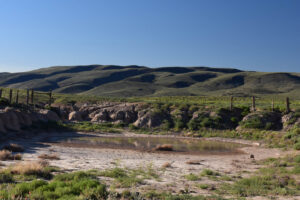
Looking north across Garfield 5890 Saddle Pond and surrounding green vegetation. The pond had almost certainly dried up by mid-May but there were thunderstorms in the area during the periods: May 20-29, June 5-6, and June 10-13. The small size of the fairy shrimp suggests they hatched after one of the June precipitation events. The pan evaporation rate of 7.5 mm/day at the Fallon Experimental Station (see Pond Duration on About page) suggests the pond didn’t last until the mid-July thunderstorms.

A male fairy shrimp (below center) with large, brownish antennae II in Garfield 5890 Saddle Pond.
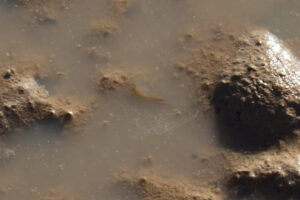
A female fairy shrimp with lots of brownish eggs in ovisac in Garfield 5890 Saddle Pond.
August 1, 2023
There was a lot of thunderstorm activity in western Nevada from July 17 through July 19 so I couldn’t help but wonder if fairy shrimp in Garfield 5890 Saddle Pond had hatched again.
- Paced off 17 m x 32 m; depth greater than 12 cm.
- Opaque water; 18 C at 1000.
- 5-10 mm fairy shrimp; some have eggs.
- Abundant tadpole shrimp (Notostraca) 15-30 mm long, water boatmen (sub-order Heteroptera, family Corixidae), damselflies, horses nearby.
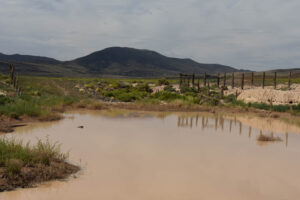
Looking south across Garfield 5890 Saddle Pond. This is a lot of water. Greasewood with green leaves in late summer confirms the rarity of the 2023 precipitation pattern.
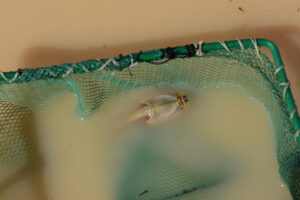
A large tadpole shrimp (Notostraca) in net at Garfield 5890 Saddle Pond. The configuration of the 3 eyes, the patterns on the carapace, and the lack of a supra-anal plate at the end of the abdomen (not visible in photograph) indicate the species is Triops longicaudatus, which is common in Nevada (Pennak, 1978, p. 346-347; see References page). These features distinguish them from the genus Lepidurus, such as the tadpole shrimp in Rowland Spring North Pond 2019-05-08, #30 and Burnt Lake Mud Bar Pond 2019-05-07, #05, Middle Washoe County.
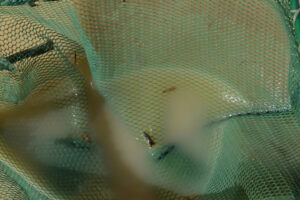
A momentarily stationary water boatman (sub-order Heteroptera, family Corixidae) in net at Garfield 5890 Saddle Pond. Its oar-like legs are extended backwards from the center of its body.
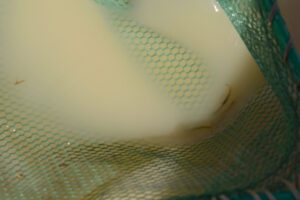
Fairy shrimp in net at Garfield 5890 Saddle Pond. Tadpole shrimp and water boatmen were rather common but I had a hard time netting fairy shrimp. Finally got 3 at the bottom of this net.
Garfield 5890 Saddle Pond Tadpole Shrimp Video 2023-08-01b-r
For a 2-minutes, 39-seconds video of tadpole shrimp (Notostraca) swimming in the shallows of opaque Garfield 5890 Saddle Pond, click on the video player above. There is no audio. The tadpole shrimp seem to be feeding on the bottom of the pond and their visibility is primarily a function of water depth. There are instances where tadpole shrimp pop up to the surface and swim for some distance rather than digging mostly in place, such as at 1:10. At 1:36, a larger tadpole shrimp nonchalantly pushes a smaller tadpole shrimp around (at center) without either paying much attention to the other. There is a good example of a tadpole shrimp swimming with legs up starting at 2:20 on the left side of the screen.
Garfield 5890 Saddle Pond Tadpole Shrimp Video 2023-08-01c-cr
For a 1-minute, 46-seconds video of tadpole shrimp (Notostraca) digging little circular depressions at the edge of Garfield 5890 Saddle Pond, click on the video player above. There is no audio. Previously excavated circles are exposed out of the water at lower right. Tadpole shrimp have various styles of digging. At times, they move their legs very rapidly and kick up a cloud of mud in the water. One particular tadpole shrimp does this at 0:13 (left of center), again at 0:21 (now above and to right of center), at 0:56 (above and to left of center), and at 1:23 (left of center). In contrast, the large tadpole shrimp at right or upper right has a slow, ratchet-like, digging style, such as at 0:04-0:17 and again at 1:00-1:10 continuing at 1:27-1:46 with 2 flicks of the abdomen. Some of the diggers are completely covered by water but some spend considerable time with almost all of their carapaces and much of their abdomens above the water. Their long exposures to air and obvious talents for crawling over the mud makes me wonder if some tadpole shrimp populations might evolve toward an amphibious lifestyle. That evidently hasn’t happened in the last 300 million or so years of notostracan existence (see When Did Anostracans and Other Branchiopod Orders First Appear on Earth? on Taxonomy and Origin of Anostraca page) so maybe they aren’t interested.
August 10, 2023
The pond is only a little smaller in spite of ongoing evaporation. There are recent horse tracks leading to the water. Streaks of green algae are floating on the water.
- Guestimate of 16 m x 25 m because it is smaller than on August 1; depth not estimated but certainly greater than 5 cm.
- Water is opaque.
- No fairy shrimp – too hard to find, eaten by tadpole shrimp, or killed off by low oxygen concentration in water?
- Tadpole shrimp (Notostraca) are still common and may be bigger, on average, at 20-30 mm.
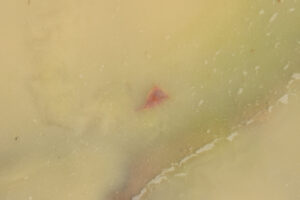
A tadpole shrimp (Notostraca) in Garfield 5890 Saddle Pond is swimming with back side down so its legs are visible at the surface. The strong red color is due to hemoglobin and may be a response to low oxygen concentration in the water (Guadagnoli and others, 2005, particularly p. 3550).
August 15, 2023
There has been more stormy weather and the horse tracks have disappeared. The pond may have received some rain but is a little smaller nonetheless.
- Guestimate of 14 m x 23 m by comparison to previous photographs; depth greater than 5 cm.
- Opaque water.
- No fairy shrimp.
- Tadpole shrimp (Notostraca) still approximately 20-30 mm long; measured a few dead ones on the mud at 22-25 mm from front of carapace to end of abdomen, near-measurement of 30 mm for one in water.
Garfield 5890 Saddle Pond Tadpole Shrimp Video 2023-08-15-cr
For a 2-minutes, 48-seconds video of tadpole shrimp (Notostraca) in Garfield 5890 Saddle Pond, click on the video player above. There is no audio. Most of the tadpole shrimp are mostly covered by water. Some are swimming more than digging and leave contrails of clay in the opaque water. Like the fairy shrimp in “Carson Lake” East Ridge Pond Fairy Shrimp Video 2022-01-31c, tadpole shrimp may leave a “puff” of clay as they dive or sharply change direction, such as at 0:43 (at left), 1:08 (at right), and 2:42 (left of center).
August 28, 2023
There were more storms in western Nevada over the period August 16-20. I stopped by Garfield 5890 Saddle Pond to see if it got any more water and found it had gotten a lot. The pond looked almost as big as on August 1.
- Looks about the same as August 1 so probably 17 m x 30 m; depth greater than 12 cm as far as I could reach with my net.
- Opaque water.
- No fairy shrimp.
- Tadpole shrimp (Notostraca), water boatmen (sub-order Heteroptera, family Corixidae).
I hadn’t seen water boatmen on August 10 or 15 but they were probably there because I found them this time.
September 12, 2023
There were thundershowers in the area on September 9-11 but they apparently missed Garfield 5890 Saddle Pond. It doesn’t look any bigger than on August 28.
- Size not estimated; depth greater than 10 cm.
- Opaque water.
- No fairy shrimp.
- Small and large tadpole shrimp (Notostraca); was there another hatch after the rains on August 16-20?
September 26, 2023
It would take the 10 cm of water estimated on September 12 about 20 days to evaporate based on the 5 mm/day pan evaporation rate at the Fallon Experimental Station so there should still be some water here. And there is.
- About 12 m x 15 m; depth 4 cm in some hoof prints and probably at least 5 cm somewhere.
- Opaque water; 18 C at 1030.
- No fairy shrimp.
- 25-30 mm tadpole shrimp (Notostraca), water boatmen (sub-order Heteroptera, family Corixidae).
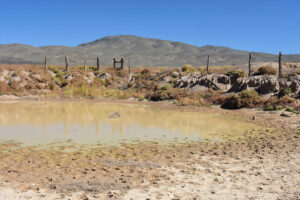
Looking northeast across Garfield 5890 Saddle Pond, like photograph Garfield 5890 Saddle Pond 2023-08-15, #20. The pond has shrunken considerably from August 1 and the greasewood has lost most of its green leaves, finally.

A tadpole shrimp at the edge of the water at Garfield 5890 Saddle Pond. The tadpole shrimp are not as abundant as before and there are a few carcasses along the shore.
October 5, 2023
- Looks the same size as on September 26, 15 m x 20 m; depth as great as 5 cm.
- Opaque water; 19 C at 1200.
- No fairy shrimp.
- Few tadpole shrimp (Notostraca), lots of water boatmen (sub-order Heteroptera).
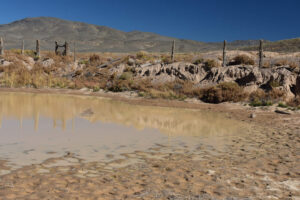
Looking northeast across Garfield 5890 Saddle Pond. Based on the distance of the top of the post at right from the edge of the water, the pond has about as much water as it did on September 26.
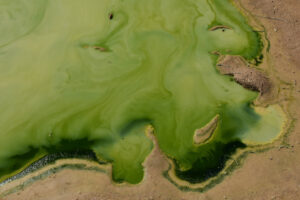
Green algae along the shore of Garfield 5890 Saddle Pond. Decomposition of the algae could lower oxygen concentrations in the water but I don’t know if it’s having a harmful effect on the tadpole shrimp. It’s not affecting the water boatmen as they are more abundant than ever.
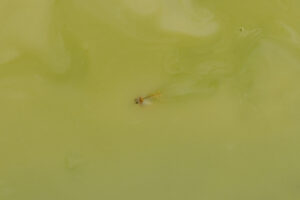
A tadpole shrimp swimming near the surface of the greenish water in Garfield 5890 Saddle Pond.
January 23, 2024
Although November and December were essentially dry (1.7 cm, 0.67″, measured in Reno), Reno got a good dump of 16 cm (6.4″) snow (2.2 cm, 0.85″, water) on January 10. Maybe that storm was enough to get this pond started.
- 15 m x 18 m; maximum depth greater than 5 cm based on pond area and previous estimates.
- Opaque water.
- No fairy shrimp.
- No other animals observed.
There’s water but not much.
February 22, 2024
Big storms on February 4-5 (2.0 cm, 0.78″, water in Reno) and February 19-20 (1.3 cm, 0.51″, water in Reno) should have helped fill up this pond.
- 19 m x 37 m; maximum depth greater than 15 cm based on pond area and previous estimates.
- Opaque water; 100% coverage by 1-2 mm thick ice at 1015.
- No fairy shrimp.
- Kestrel, maybe headed north.
Yep, the pond is as full as I have ever seen it. Although I had seen fairy shrimp on February 17 in 2022, the ice suggests the temperature may still be too cold this year.
February 27, 2024
Although early February was cooler than normal in Reno and presumably all of western Nevada, temperatures were 1.1-4.4 C above normal February 14-21. Maybe fairy shrimp hatched during that period but were too small to see on the 22nd, or I couldn’t see them because of the ice.
- 18 m x 35 m; maximum depth greater than 15 cm based on pond area and previous estimates.
- Opaque water; 25% of pond still covered by 1-2 mm thick ice and water is 7 C at 1130.
- No fairy shrimp.
- No other animals observed.
March 19, 2024
The biggest storm of the year in Reno on March 1-3 with a total of 2.8 cm (1.1″) water, including 24 cm (9.4″) snow on March 2. However, temperatures during the first 9 days of the month were 0.6-7.2 C below normal with lows mostly below freezing and with all but 1 high below 13 C. With all this water, what are the eggs thinking? Still too cold? Can they sense the equinox is almost here and warmer water is a very good bet? Or are they keying on something else?
- 17 m x 27 m; maximum depth greater than 5 cm.
- Opaque water; 10 C at 1100.
- Pale gray fairy shrimp 8-12 mm; all sizes have eggs.
- Water boatmen about 10 mm long (sub-order Heteroptera, family Corixidae).
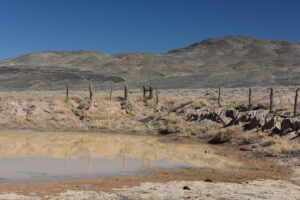
Garfield 5890 Saddle Pond with Mable Mountain in distance. A relatively high water level is indicated by the edge of water being above the top of the post at right.
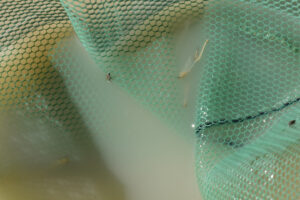
Fairy shrimp in the net at Garfield 5890 Saddle Pond. The female with eggs is about 12 mm long while there is a smaller fairy shrimp below it. These lengths are consistent with fairy shrimp hatching in the first few days after the cold spell ending on the 9th (assuming a growth rate of about 1 mm/day).
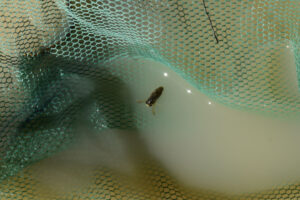
Water boatman in the net at Garfield 5890 Saddle Pond. The length of this water boatman is within the range of the fairy shrimp lengths. It could have hatched at the same time if it grew at the same rate.
September 4, 2025
There were scattered thunderstorms in western Nevada during the period Aug. 23-27. When I turned off US 95 onto the road to Garfield Flat on Aug. 28, I found that it had been heavily damaged by flooding, probably on Aug. 27. There were no tire tracks across the mud on the road. There was large gravel or mud spread across the road in various places. Though passable with 4-wheel drive, the going was so slow and bumpy I turned around after about 3 miles. The flooding could actually be good for the fairy shrimp eggs in Garfield 5890 Saddle Pond so I came back. The road hadn’t been fixed but it was at least dry. As I got farther from the highway though, the signs of flooding got less and less dramatic until they disappeared well before I got to the pond. I wasn’t sure what to expect.
- Water only in hoof prints up to about 20 cm across; maximum depth less than 4 cm.
- Opaque water; temperature not measured.
- Fairy shrimp lengths highly uncertain as I can’t use the net in the hoof prints and the fairy shrimp are barely visible and often curved rather than straight, maybe 10-12 mm; larger ones have eggs.
- Tadpole shrimp (Notostraca) 15-30 mm long (I can see the carapaces but am not sure where the abdomens end); 6 antelope were at the pond when I arrived, lots of horse tracks all around the pond.
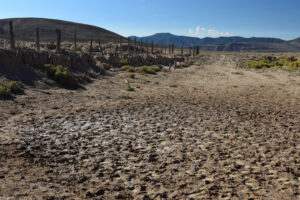
Hoof prints with a little water in Garfield 5890 Saddle Pond, looking south. The thunderstorms must not have dropped much water here as it’s been only 6-10 days. For a pan evaporation rate of 7 mm/day (0.276″) at the Fallon Experimental Station (see “Pond Duration” on the About page), only 4-7 cm “1.6-2.8”) would have evaporated in that time span. Fairy shrimp eggs here didn’t hatch after the August 16-20, 2023 storms (see August 28, 2023 visit). Distance is distorted by the very wide angle of the lens setting, focal length 27 mm.

A male and a female fairy shrimp are swimming at the surface of opaque water in Garfield 5890 Saddle Pond near the top of the photograph. The male is pointing to the lower right. Its antennae II form a U shape as their ends touch. The splayed cercopods at the end of its abdomen are also visible. The female’s head is almost touching the male. Its eyes, the ocellus between them, and the tops of its legs are visible. It lacks prominent antennae II.
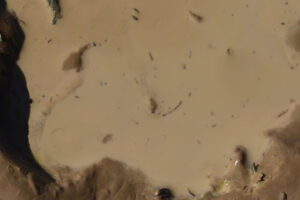
2 tadpole shrimp at the surface of opaque water in Garfield 5890 Saddle Pond. The one at center is headed toward the bottom of the photograph. It has 2 dark, closely spaced eyes on the leading edge of its shield-like carapace and a dark nuchal organ behind and between them. There is another tadpole shrimp evidently out of focus near the top, to the right of center, without conspicuous eyes but most of its carapace is visible.
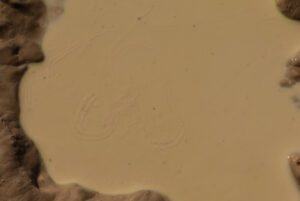
The curved wakes of fairy shrimp swimming in the opaque water of a hoof print in Garfield 5890 Saddle Pond. Did they write I-O-U?
Garfield 5890 Saddle Pond Fairy Shrimp Video 2025-09-04a-r
For a 2-minutes, 43-seconds video of fairy shrimp shrimp swimming in the hoof prints in Garfield 5890 Saddle Pond, click on the video player above. There is no audio. Sometimes the U shaped antennae II of the males or a hint of the legs of females can be seen at the surface and sometimes only the wakes caused by their swimming. Given the small size of the hoof print, the fairy shrimp generally follow curved paths and sometimes change direction sharply. As if we needed evidence that fairy shrimp don’t see well in opaque water, a fairy shrimp bounces off the left edge of the hoof print at 0:02. At 1:01, another fairy shrimp turns away with less commotion after touching the upper left edge. 2 males collide at the left edge at 0:47. Jerking motions could be responses to encountering obstacles or other fairy shrimp. Examples are at 0:31-0:37, 1:10-1:11, 1:35-1:42, and 2:15-2:16. The last case involves fairy shrimp which can be identified as male and female. This may be an example of clasping behavior in which the female rejects the male (see Fairy Shrimp Mating Dance, Fairy Shrimp Reproduction, Life Cycle of Fairy Shrimp). A dark shape appears at the surface and quickly disappears at 2:36 and 2:39 but I can’t identify it even after slowing and enlarging the video. Best guess is a water boatman coming to the surface for air. They were observed in this pond in August 2023 and later this year on Oct. 30.
Garfield 5890 Saddle Pond Fairy Shrimp Video 2025-09-04b-r
For a 1-minutes, 51-seconds video of tadpole shrimp and fairy shrimp swimming around a hoof print in Garfield 5890 Saddle Pond, click on the video player above. There is no audio. A tadpole shrimp can be distinguished by the dark, linear crease of its carapace, which looks like a backbone, and by its swimming faster than fairy shrimp. As if we needed evidence that tadpole shrimp don’t see well in opaque water, there is a tadpole shrimp – fairy shrimp collision to the left of center at 0:15. A tadpole shrimp performs a rapid U turn at 0:37-0:38 on encountering the edge of the hoof print at lower right. 2 tadpole shrimp collide at the right edge of the hoof print at 1:02-1:05. At 1:32-1:35, a tadpole shrimp seems to feel its way along the left edge of the hoof print.
October 9, 2025
Western Nevada got a good rain on Oct. 2-3. Reno received a total of 1.07 cm (0.42″). Fairy shrimp had hatched in late August. Would they hatch again? And what about the tadpole shrimp? Is it still warm enough for them?
- 20 m x 36 m; depth greater than 22 cm by reference to Dec. 9 measurement.
- Opaque water; temperature not measured.
- Caught a few fairy shrimp in the net but they are so small it’s hard to tell how long they are, maybe 5-6 mm; no eggs.
- No other aquatic animals seen.
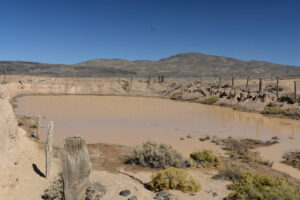
This is the fullest I have ever seen Garfield 5890 Saddle Pond. This late in the year, it will likely last a long time due to cooler weather. How long will the fairy shrimp last? Distance is distorted by the very wide angle of the lens setting, focal length 26 mm.
October 16, 2025
Time for another look at Garfield 5890 Saddle Pond to see how the fairy shrimp have grown up. There was more rain on Oct. 13-14 so the pond should be really full.
- 20 m x 38 m; depth greater than 22 cm by reference to Dec. 9 measurement.
- Opaque water; 10 C at 1300 in 6 cm water.
- Lots of fairy shrimp 7-10 mm; larger ones have eggs.
- No other aquatic animals seen.
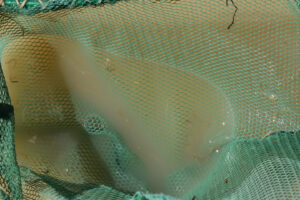
These fairy shrimp in the net at Garfield 5890 Saddle Pond haven’t grown much. All of these look to be less than 10 mm long. 2 of the fairy shrimp in the water have eggs. The different sizes of the 2 out of the water at right suggests the fairy shrimp may have hatched over several days. If any fairy shrimp hatched because of the rain on Oct. 13-14, they would be too small to catch in the net. I’ll just have to come back later to see if they are here.
October 30, 2025
The pond should still have plenty of water. Time to see if a second generation of fairy shrimp hatched on Oct. 14.
- 17 m x 34 m; depth greater than 22 cm by reference to Dec. 9 measurement.
- Opaque water; 13 C at 1300 in 3 cm water.
- Lots of fairy shrimp, almost all look about 10-12 mm long but maybe there are a few up to 15 mm; eggs are common.
- Common water boatmen about 8 mm long.
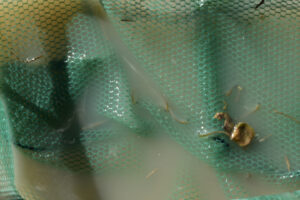
Numerous fairy shrimp in the net at Garfield 5890 Saddle Pond. These fairy shrimp are twisting and turning so much and going in and out of view in the opaque water that it’s hard to get a handle on the size distribution. 2 females at right have ovisacs full of white eggs.
The size distribution of the fairy shrimp today does not appear to have a bimodal pattern that would clearly indicate 2 distinct hatching periods. However, the abundance of fairy shrimp does suggest a second hatch after the rain or snow on Oct. 14. Previous observations here on Feb. 17 and March 14 in 2022 indicated the fairy shrimp grew at a rate of about 0.2 mm/day from 7 mm to 12 mm (see also Winter 2022 Fairy Shrimp Hatching History in the Garfield and Candelaria Hills and the Gabbs Valley Range). At that rate, 7-10 mm fairy shrimp on Oct. 16 would be 10-13 mm long today. It’s possible there was not another hatch. However, temperatures are colder in February and March than in October and fairy shrimp commonly grow faster in warmer weather (see Fairy Shrimp Growth on the Life Cycle of Fairy Shrimp page). An average growth rate of 0.75 mm/day (e.g., 1 mm/day for 10 days followed by a post-maturity rate of 0.35 mm/day for 6 days) for generation II from Oct. 14 to reach 12 mm today is certainly plausible as is a slower growth rate of 0.35 mm/day for the older generation I to reach 15 mm today. Relatively cool daily lows of 5 C and 3 C (41 F and 37.4 F) in Reno on Oct. 14 and 15 would not impede hatching. Hatching patterns observed in January-March 2022 for ponds in the Garfield Hills and Candelaria Hills, on Rawhide Flats and “Carson Lake” Playa, and in Soda Spring Valley have a complex, if any, relationship with temperature.
November 26, 2025
California got hit by an atmospheric river in mid-November and some of that spilled over into western Nevada. Reno received 3.9 cm (1.5″) precipitation during the period Nov. 13-20. The pond couldn’t have dried up since Oct. 30. The surface could have frozen on several nights though. Low temperatures in Reno have been less than 4.4 C (40 F) since Nov. 16 and were below freezing on 5 mornings.
- 18 m x 36 m; depth greater than 22 cm by reference to Dec. 9 measurement.
- Opaque water; 8 C at 1400 in 4 cm water.
- Few fairy shrimp, most 10-12 mm long but caught one that could be 15 mm; white eggs common in 2 rows (oviducts?) or in 1 (ovisac).
- Water boatmen also not abundant and less than 8 mm long.
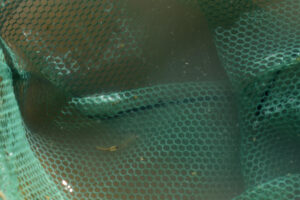
A single fairy shrimp in the net at Garfield 5890 Saddle Pond. It has 2 rows of white eggs. This one is not much longer than 10 mm, pretty much the same length as most of the fairy shrimp on Oct. 30. It could have hatched on Nov. 15, after the first good rain/snow in mid-November, and grown at about 1 mm/day. That seems unlikely given the cool temperatures. It’s possible that it is the same generation, or two, as the 10-12 mm fairy shrimp on Oct. 30 and hasn’t grown at all. The low population density today indicates many fairy shrimp of that generation(s) must have died. If there was a hatch in mid-November, most or all of the earlier generation(s) must have died. Flip a coin. It may also be worth noting that today all the fairy shrimp I have caught have been very active in the net, unlike on previous visits.
December 9, 2025
Nights have remained cold since Nov. 26. All lows in Reno were below 1.5 C (35 F) and one was -5 C (23 F). I’ve waited until the afternoon to avoid any ice that probably formed overnight.
- 17 m x 33 m; depth at least 22 cm.
- Opaque water; 7 C at 1500 in 3 cm water.
- No fairy shrimp.
- A few water boatmen less than 8 mm long.
The depth of the pond indicates it couldn’t have frozen solid. If the food supply got low, one would expect at least a few fairy shrimp to survive. Maybe the water temperature got too low.
Winter 2022 Fairy Shrimp Hatching History in the Garfield and Candelaria Hills and the Gabbs Valley Range
The presence of fairy shrimp in ponds in January and February after 2 major storms in December presents an opportunity to try to figure out when they hatched and why. The unusual weather pattern of winter 2021-2022 means the date when the ponds in western Nevada filled up with water (i.e., the earliest hatching date) can be determined easily. Temperature and precipitation data for Reno are available from NOAA Online Weather (NOW) Data at www.weather.gov/wrh/Climate?wfo-rev or from WFO monthly summaries at forecast.weather.gov/product.php?site=CRH&issuedby=RNO&product=CF6&format=CI&version=2&glossary=0 (“RNO” is the code for Reno and the last full month of data is on page 2). Although precipitation amounts at various ponds in western Nevada may have differed from those in Reno, the timing of large precipitation events is unlikely to have differed from Reno by more than a day (EIGWUU). The latest a particular generation of fairy shrimp in a particular pond could have hatched is constrained by my first observation of them. This constraint can be considerably tightened by assuming a reasonable growth rate and extrapolating back to zero body length.
Reno weather strongly suggests the earliest possible winter 2021-2022 hatching date for fairy shrimp in western Nevada was December 23. There was negligible precipitation in Reno in November. 7.4 cm of precipitation (as depth of water) fell during a big storm on October 24-25 but any ponds that formed then and any fairy shrimp in them are unlikely to have survived until January due to the mid-December freeze (see below). Reno received 7.1 cm of precipitation in the period December 12-26. Reno received 0 cm precipitation in January and 1.1 cm on February 21-23. Consequently, any ponds found before February 21 must have formed in the period December 12-26.
Hatching dates within the December 12-26 period can be further constrained by temperatures and the precise timing of precipitation. Reno received less than 0.5 cm of precipitation on December 6th, 9th, and 12th and then 2.1 cm on December 13-14 during the first big storm of December. Ponds likely formed as a result of this storm. However, averages of the daily high and low temperatures in Reno for December 14-21 were -1.9 to 2.2 C with only 2 daily averages above 0 C. On December 22, Wrecked Windmill Pond and Playa Wire Gate Pond (in Soda Spring Valley) were found to be frozen solid with up to 10 cm of ice and condensed snow just before the second December storm. These ponds are less than 150 m (490′) higher in elevation than those on “Carson Lake” Playa and Rawhide Flats and more than 370 m (1,210′) lower than ponds in the Garfield Hills, Candelaria Hills, and Gabbs Valley Range. Even if fairy shrimp hatched before the water froze, they would have been frozen in the ice over the next few days. December 23 was the big dump of the second storm with 3.6 cm. Another 0.9 cm accumulated over the next 3 days. Temperatures were warmer on December 22-24 but then the daily averages of the high and low temperatures were 0.6 C or less from December 26 to January 2, except for 2.8 C on December 30. Most ponds likely froze solid again. Thus, while it is possible that liquid water and fairy shrimp that hatched as early as December 23 survived (e.g., due to greater water depths, insulating effects of snow cover), the most probable hatching dates are after January 2 as snow and ice in the ponds melted.
The latest that fairy shrimp could have hatched is the day before I observed them. A guess of how long before my observation they hatched can be based on a growth rate. Daborn (1977, see the References page) found an average rate of about 1 mm/day for a Branchinecta mackini population in a clay-rich Alberta pond. Other B. mackini populations on a playa in the Mojave Desert grew at rates of 0.6-2 mm/day at various times over 2 years (Brown and Carpelan, 1971). A winter generation of Eubranchipus holmani had growth rates of 0.87 mm/day for the first 9 days and then 0.32 mm/day (Moore, 1963). Brown and Carpelan (1971) inferred that the rapid growth of B. mackini in the Mojave Desert almost stopped once they reached a 10 mm length while the gonads developed. Growth resumed after maturation and the rate decreased as the maximum length was approached. Another consideration is that fairy shrimp grow more slowly in cold water than warm water, e.g. Mono Lake fairy shrimp as reported by Jones & Stokes Associates (1993b, p. J-2). To simplify the analysis I just assume a growth rate of 1 mm/day and then check to see if the result is reasonable.
How do you figure out why they hatched? Laboratory experiments have shown that fairy shrimp species hatch at some temperatures and TDS concentrations but not at others (e.g., Horne, 1967; Brown and Carpelan, 1971; Belk, 1977; see Habitats of Fairy Shrimp). I can’t measure TDS, or a TDS proxy like conductivity, but I know most ponds had their minimum TDS concentrations whenever the ice melted after the second December storm. Once all the ice and snow had melted, TDS would increase continually with slow winter evaporation. Thus, fairy shrimp either hatched at the minimum TDS of the thaw or during a later period of rising TDS, notwithstanding TDS changes related to daily freeze-thaw cycles of surface ice. As for temperature, I can use the maximum and minimum daily temperatures in Reno as reported on National Weather Service web pages (see above) to define temperature trends. The trends, at least, should be more or less the same throughout western Nevada. This gives me 4 possible causes to choose from:
- They hatched upon first pond filling/melting.
- They hatched during a period of rising temperature.
- They hatched during a period of falling temperature.
- They hatched during a period of trendless temperature.
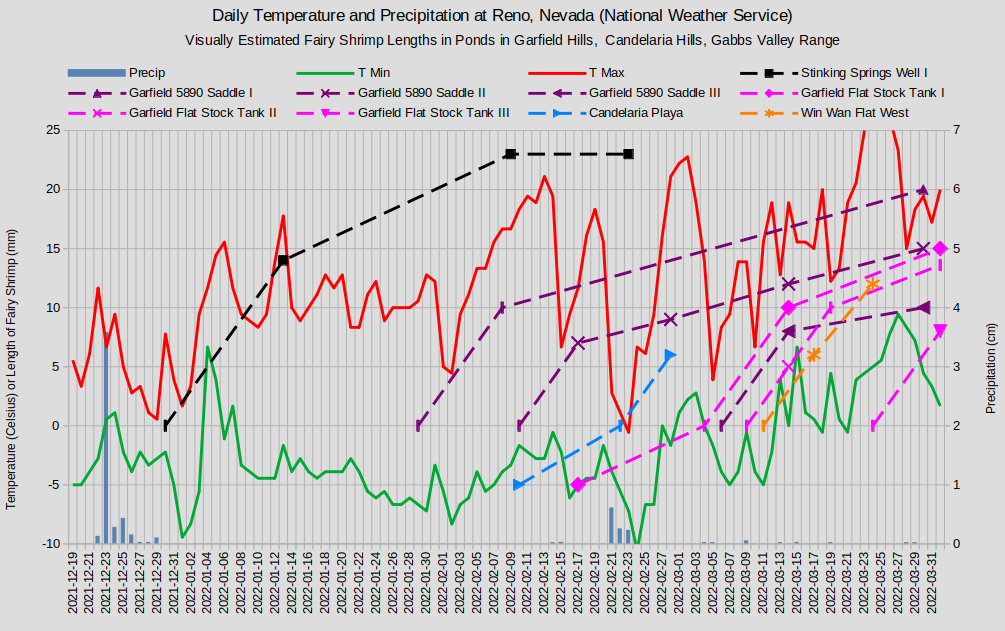
Fairy shrimp lengths are indicated by the dashed lines where 0 lengths are on the inferred days of hatching. The vertical dash symbol indicates a calculated length. From hatching to 10 mm length, the growth rate is assumed to be 1 mm/day. For post-10 mm growth rates, see text below. -5 fairy shrimp lengths mark dates when fairy shrimp were not observed. Garfield 5890 Saddle Pond generation IV is not shown because it would obscure Garfield Flat Stock Tank Pond generation III. Growth of the first generation in Stinking Springs Well Pond is shown for comparison.
Fairy shrimp were first observed in Garfield 5890 Saddle Pond on February 17 with an estimated median length of 7 mm. If this generation II had grown at a rate of 1 mm/day, they would have hatched on February 10. Any growth rate from 0.54 mm/day to 1.75 mm/day would have Garfield 5890 Saddle Pond generation II hatching during a strong warming period. If the largest observed fairy shrimp in the pond on subsequent visits were also generation II, the growth rate decreased after February 17. The precise date of the decrease cannot be determined due to the infrequent observations. The growth rate of generation II averaged 0.20 mm/day from February 17 to March 14 and was approximately the same before and after the observation on February 28. This is only 63% of the rate observed by Moore (1963; see the References page) for mature E. holmani and less than all the rates reported by Brown and Carpelan (1971) for B. mackini in Mojave Desert playa ponds. Slow growth between February 17 and February 28 could be due to the sharp cold snap but that would not explain the continued slow growth to March 14.
On March 14, a third generation of fairy shrimp with lengths of about 8 mm was observed in Garfield 5890 Saddle Pond. At 1 mm/day or higher growth rates, generation III would have hatched during a short period of rising highs but falling low temperatures after March 5. They could have hatched during a period of falling temperatures if the growth rate was about 0.8 mm/day or less.
Garfield 5890 Saddle Pond was dry on April 1 but the remains of many fairy shrimp were present on the surface of the damp mud. This allowed their lengths to be measured. However, the curvature of the bodies and commonly missing abdomen tips made the measurements somewhat subjective (see photographs for April 1). For discussion purposes, it is assumed that the last of the water evaporated on March 30. Most of the remains were about 15 mm long. If generation II had grown from 12 mm long on March 14 at a rate of 0.2 mm/day, they would have been 15.2 mm long on March 30. At such a slow growth rate, lengths of generation II would differ from 15 mm by less than 1 mm even if the pond dried up 3 days before or 2 days later than March 30.
The remains in Garfield 5890 Saddle Pond also included remains about 10 mm long. These are likely generation III as the lengths of generation III would have been 11.2 mm on March 30 at a 0.2 mm/day growth rate. This is within the uncertainties of my visual estimates of length. There are additional uncertainties due to the unknown variance of lengths within a generation of fairy shrimp and to the representativeness of my measurements on March 14, or on April 1, or both.
Photograph Garfield 5890 Saddle Pond 2022-04-01, #21, indicates there were fairy shrimp remains as small as 7 mm on April 1. For a 1 mm/day pre-maturity growth rate, these generation IV fairy shrimp would have hatched on March 23. This is at the beginning of a warm spell following more than a week of trendless temperatures and approximately the same day that Garfield Flat Stock Tank Pond generation III likely hatched. Generation IV is not shown on “Graph of Temperature and Precipitation in Reno and Fairy Shrimp Lengths in Garfield 5890 Saddle Pond and Garfield Flat Stock Tank Pond in Garfield Hills, Candelaria Playa Ponds in Candelaria Hills, and Win Wan Flat West Pond in Gabbs Valley Range, Winter 2022” because it would obscure generation III in Garfield Flat Stock Tank Pond.
Garfield 5890 Saddle Pond contained fairy shrimp remains as long as 20 mm on April 1. These likely represent the first generation to hatch. To reconstruct their growth trajectory, I assumed a pre-maturity growth rate of 1 mm/day, a mature length of 10 mm (greater than the apparent inflection for generation II but less than that for Stinking Springs Well Pond generation I), and a post-maturity growth rate of 0.2 mm/day. As shown on “Graph of Temperature and Precipitation in Reno and Fairy Shrimp Lengths in Garfield 5890 Saddle Pond and Garfield Flat Stock Tank Pond in Garfield Hills, Candelaria Playa Ponds in Candelaria Hills, and Win Wan Flat West Pond in Gabbs Valley Range, Winter 2022”, the result indicates they would have hatched on about January 29 during a period of trendless temperatures. Other reasonable assumptions could have generation I hatching more than a week before or a week after that date. More importantly, if the post-maturity growth rate was the same as that for generation II, generation I would have been about 5 mm longer from the time generation II was first seen on February 17. That’s enough of a difference to be visually distinct, at least on February 17 and February 28, so I may have missed them. Alternatively, a growth rate of 0.32 mm/day, which is about the same as that for Stinking Springs Well Pond generation I, would have generation II growing from the generation II length of 7 mm on February 17 to 20 mm on March 30. However, if generation I and generation II are the same, other generations must account for the 9 mm long fairy shrimp on February 28 and the 12 mm fairy shrimp on March 14. Isn’t this fun?
Fairy shrimp were not observed in Garfield Stock Tank Pond on February 17 during the first visit. On February 28, the ice cover was too thick and too extensive to determine if fairy shrimp were there or not. On March 14, Garfield Stock Tank Pond generation I was about 10 mm long. On April 1, they were about 15 mm long. That indicates a growth rate of 0.28 mm/day. 0.28 mm/day is 40% greater than the 0.20 mm/day growth rate for generation II in Garfield 5890 Saddle Pond but less than the 0.33 mm/day post-maturity growth rate of Stinking Springs Well Pond generation I.
Garfield Flat Stock Tank Pond generation II was about 5 mm long on March 14. Assuming a pre-maturity growth rate of 1 mm/day, it reached an assumed mature length of 10 mm on March 19. If it had the same post-maturity growth rate as Garfield Flat Stock Tank Pond generation I, 0.28 mm/day, it would have been 13.6 mm long on April 1. This is pretty close to the 15 mm median length of generation I. Adding to the difficulty of distinguishing generation I and generation II on April 1, I was able to net only a few fairy shrimp.
On April 1, Garfield Flat Stock Tank Pond had fairy shrimp about 8 mm long in addition to the longer generation I. It is conceivable that they were generation II. If so, that implies generation II reached a mature length at 5 mm and had a post-maturity growth rate of 0.17 mm/day. It is more likely that the 8 mm long fairy shrimp are generation III and hatched on March 24 or thereabouts. This date is at the beginning of a warming trend following a period of trendless temperatures.
Hatching of fairy shrimp in Garfield 5890 Saddle Pond before hatching in Garfield Flat Stock Tank Pond is contrary to what one would expect based on elevation as a proxy for temperature. Garfield 5890 Saddle Pond is 90 m (300′) higher than Garfield Stock Tank Pond, which is only about 9 km (5.6 miles) away. Because temperatures generally decrease with elevation, that would suggest Garfield 5890 Saddle Pond is colder. In fact, it was not. Garfield 5890 Saddle Pond was 3 C warmer in the afternoon of February 17 and 10 C warmer on March 14. Ice was also thinner and less extensive in Garfield 5890 Saddle Pond than in Garfield Flat Stock Tank Pond on the same days. The difference in temperatures could be due to thermal inversion. Another possibility is the shadowing effect of bushes. When ice is present, it is most abundant under adjacent bushes. This was particularly noticeable at Grimes Point West Pond compared to Macari East Stop Sign Pond (see “Carson Lake” Playa). The dike around Garfield Flat Stock Tank Pond has numerous greasewood bushes but there are none adjacent to Garfield 5890 Saddle Pond. A third possible explanation is that the excavation containing Garfield 5890 Saddle Pond traps heat and reduces the cooling effects of wind.
Fairy shrimp in Candelaria Playa Ponds did not hatch upon initial pond filling or thawing of ice and snow. There was ample water but no fairy shrimp on February 10 near the end of a significant warming period. Fairy shrimp were first observed on February 28. Assuming a 1 mm/day growth rate, the 6 mm fairy shrimp hatched on about February 22. This is during a period of rapidly falling temperature. The high in Reno on February 19 was 18.3 C (65 F) but only -0.6 C (31 F) on February 23. It seems likely the hatch was stimulated by a reduction in TDS of the water due to precipitation on February 21, when Reno received 0.6 cm. The importance of TDS reduction as a hatching trigger was established by Brown and Carpelan (1971). They reported that fairy shrimp in Mojave Desert ponds commonly hatched after precipitation events and even after the melting of surface ice.
Fairy shrimp in Win Wan Flat West Pond were about 6 mm long on March 17 and about 12 mm on March 24. This indicates an average growth rate of 0.86 mm/day. These observations are particularly important because they are the only case where I was lucky enough to make 2 pre-maturity, or close to pre-maturity, observations. They indicate that assuming a pre-maturity growth rate of 1 mm/day is reasonable and that assuming a mature length equal to, or greater than 10 mm, is reasonable. Win Wan Flat West Pond generation I could have been mature at lengths somewhat shorter than 12 mm and grown more slowly thereafter but this cannot be determined due to the infrequent observations. The hatching date of March 11 shown on the graph is based on a pre-maturity growth rate of 1 mm/day. This day occurs during a period of generally rising temperatures from March 5 to March 12.
For other hatching histories see “Winter 2022 Fairy Shrimp Hatching History in Soda Spring Valley and Rhodes Salt Marsh” on the Soda Spring Valley page and “Winter 2022 Fairy Shrimp Hatching History on “Carson Lake” Playa and Rawhide Flats” on the “Carson Lake” Playa page.
Hatching dates of the first generations in the ponds I visited in January – March 2022 are summarized in “Table of Hatching Dates of the Oldest Fairy Shrimp Generations Observed in Western Nevada in Winter 2022″ Calculated Assuming Growth Rates of 1 mm/day”, below.
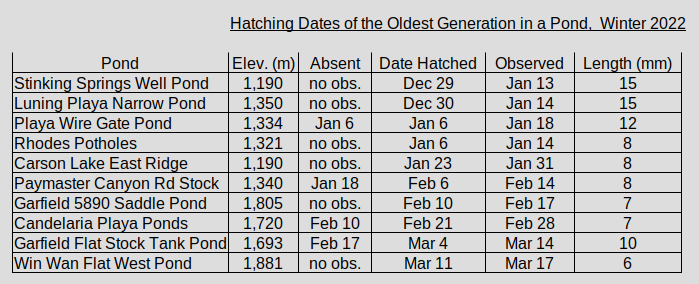
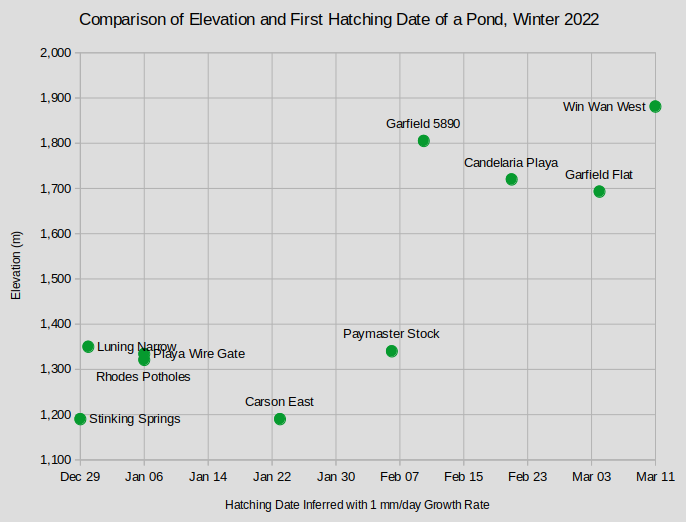
Growth rates were assumed to be 1 mm/day until the time of first observation.
Rhodes Potholes has a species of Artemia, which is different from all the other ponds.
The first generations in Bass Flat Southwest Pond and Macari East Stop Sign are not included because they were probably past the inflection from pre-maturity to post-maturity growth rates.
The first generation in Wrecked Windmill Pond is not included because hatching may have been caused by turning the well on.
As shown on “Graph of Pond Elevations vs. Hatching Dates of the Oldest Fairy Shrimp Generations Observed in Western Nevada in Winter 2022 Calculated Assuming Growth Rates of 1 mm/day”, fairy shrimp in the Garfield Hills, Candelaria Hills, and Gabbs Valley Range hatched significantly later than those on “Carson Lake” Playa, Rawhide Flats, Soda Spring Valley, and Rhodes Salt Marsh. There is a strong correlation between hatching date and elevation, which could be related to temperature (except see discussion above for Garfield 5890 Saddle Pond and Garfield Flat Stock Tank Pond). The coefficient of determination (r-squared) of the regression with hatching date as the dependent variable is 0.71 and the standard error is 15.4. At first glance, however, the relation appears to be step-wise rather than linear. Maybe it is due to different species at lower and higher elevations. Omitting the generations that hatched on or before January 6 because they may have responded to influx of water rather than temperature improves the standard error to 11.1 but the coefficient of determination decreases to a still strong 0.68. Omitting Candelaria Playa Ponds because hatching there was probably sparked by precipitation and Garfield 5890 Saddle Pond because it is the only pond of the group that could remain above a thermal inversion layer, results in a whopping coefficient of determination of 0.98 and a standard error of only 3.5. Such data manipulation is realistic but I won’t try to justify it.
The fact that many fairy shrimp generations appear to have hatched during periods of trendless or declining temperatures suggests that recent temperature is not a good predictor of hatching at individual ponds for the ponds I visited. Ice cover may not be much help either. Candelaria Playa Ponds didn’t have fairy shrimp on February 10, when ice cover on the northern pond was less than 50% but Win Wan Flat West Pond did have fairy shrimp on March 17 when ice cover was still 80% or more. Water pressure, or depth, is unlikely to have provided any hatching cues as it likely decreased monotonically due to evaporation until precipitation on February 21. 1-2 cm (0.4-0.8″) of water would evaporate every 10 days based on the January and February pan evaporation rates of 1.1 and 2.0 mm/day at Fallon Experimental Station (see “Pond Duration” on the About page).
Nor can a decrease in TDS be invoked as TDS likely increased in all ponds from December 30 to February 20. Brown and Carpelan’s (1971) observation that eggs in the Mojave Desert hatched in response to ice-melting events doesn’t seem relevant here because these Nevada ponds likely iced over and thawed almost every day. Moreover, the few fairy shrimp generations that appear to have hatched during the early January thaw provide only equivocal evidence as they might have hatched upon melting of the December 23-25 snow and grown very slowly thereafter. The cold snap on February 1-2 would have resulted in thicker ice than usual and a greater TDS change upon melting but only the Paymaster Canyon Road Stock Pond fairy shrimp hatched within the following 7 days. Conversely, Macari East Stop Sign Pond generation II, “Carson Lake” East Ridge Pond generation I, Stinking Springs Well Pond generation III, Bass Flat Southwest Pond generation II, and possibly Garfield 5890 Saddle Pond generation I hatched before the cold snap during the trendless temperature period from about January 18 to January 30.
Maybe I should just accept the fact that a resting egg with no detectable metabolic activity implements a hatching algorithm more complex than a single-variable temperature model or any other model that I can think of. This of course leads to another question. If a nauplius won’t risk popping out of its shell in the winter whenever the water warms up, what does that tell us about the climate, or the effects of past climates on the conditioning of the egg banks of the fairy shrimp populations I visited?
What Can We Learn from the Ponds in the Garfield Hills?
A pond on Garfield Flat playa had fairy shrimp while the playa itself did not. This situation is similar to Main and North Smith Creek Playa Lakes in Smith Creek Valley and Luning Playa Lake in Soda Spring Valley, where fairy shrimp are more common in deeper anthropogenic and natural puddles than in playa lakes.
At least during the late winter of 2022, fairy shrimp hatched earlier in the higher elevation Garfield 5890 Saddle Pond than in Garfield Flat Stock Tank Pond. A persistent thermal inversion may have kept the higher pond warmer over the relevant period.
Fairy shrimp in the Garfield Hills can hatch in the winter and live in ponds that ice over at night but they don’t always do so. They hatched in Garfield 5890 Saddle Pond by mid-February in 2022 when the afternoon water temperature was 9 C (6 C and 8 mm ice at 0930). However, they hadn’t hatched by late February in 2024 when the mid-day temperature was 7 C (25% cover of 1-2 mm ice). Average February air temperatures in Reno were 3.9 C in 2022 and 5.1 C in 2024.
During the remarkably wet 2023, fairy shrimp in Garfield 5890 Saddle Pond hatched before the pond dried up in April and again in June and July after thunderstorms. The July population died out in the first week of August although the pond still had more than 5 cm of water. They also hatched after late August thunderstorms in 2025 but the pond lasted less than a month. Fairy shrimp hatched again after an early October rain. Whether or not any hatched after mid-October or mid-November rains, fairy shrimp were still present on Nov. 26 but not on Dec. 9, 2025.
In 2023, tadpole shrimp hatched in Garfield 5890 Saddle Pond during July and persisted into early October thanks to thunderstorms in July, August, and September. In 2025, tadpole shrimp hatched after late August thunderstorms but not after the pond had dried up and then refilled following early October rain.
Based on macroscopic characteristics, tadpole shrimp seen in the Garfield Hills are the species Triops longicaudatus, like those in Kibby Wells Road Junction Pond and Windy Gravel Pit Pond in McLeans Valley and in Kibby Flat Playa Lake in Monte Cristo Valley and unlike the Lepidurus tadpole shrimp in Middle Washoe County and the Hays Canyon Range.